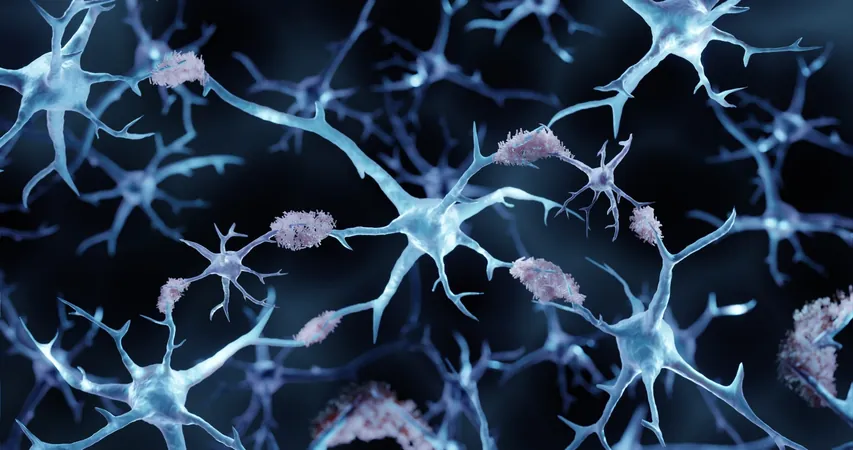
Breakthrough Discovery: How Toxic Tau Propagates Brain Damage in Progressive Supranuclear Palsy
2025-07-23
Author: Nur
In a groundbreaking study, scientists at the UK Dementia Research Institute have unveiled critical insights into progressive supranuclear palsy (PSP), a debilitating neurodegenerative disease. Their research reveals how harmful tau proteins navigate between neurons, triggering synapse loss and potentially paving the way for new therapeutic targets to combat this devastating condition.
Understanding the Impact of PSP
PSP is a rare and aggressive neurodegenerative disorder typically emerging in individuals in their mid to late 60s. It manifests in debilitating problems related to movement, cognition, and behavior, with symptoms often escalating rapidly and leading to severe disability within just five years. Unfortunately, there are currently no known treatments that can decelerate or halt the disease's progression.
Tau's Toxic Journey
At the heart of PSP's pathology lies the accumulation of toxic tau proteins within neurons, which then propagate throughout the brain. Previous studies have pointed towards synaptic deterioration in regions affected by this toxic tau; however, the mechanism of this spread remained elusive.
Revolutionary Research Techniques
Neuroscientist Dr. Robert McGeachan, analyzing post-mortem brain samples from PSP patients, discovered tau's troubling presence within synaptic connections, directly correlating it with synapse death—signifying its likely toxic nature. What’s more, the research team identified that tau proteins could potentially 'jump' from one neuron to another via synapses.
Discovering Synaptic Dynamics
Utilizing innovative techniques developed in collaboration with neurosurgeon Prof. Paul Brennan, the researchers examined live human brain slices infused with tau from affected individuals. They noted that toxic tau was absorbed by post-synaptic neurons, which incited astrocytes—supportive cells in the brain—to consume synaptic structures, further reinforcing tau's harmful influence.
Tau: The Spreader of Synaptic Malfunction
This synaptic transfer of tau is critical; since neurons form connections across distant brain regions, this mechanism might elucidate the extensive spread of tau pathology throughout the brain. As Prof. Tara Spires-Jones remarked, this understanding offers a glimmer of hope for targeting tau to potentially slow PSP progression.
Clusterin: A Promising Player?
Additionally, the research highlighted the role of clusterin, a protein previously associated with Alzheimer’s disease, in the context of tau toxicity. Clusterin was found co-located with toxic tau in synapses, pointing towards its potential involvement in the degeneration and spread of taurine in PSP.
Hope for the Future
Dr. Claire Durrant emphasized that this combination of post-mortem analysis along with live tissue studies is invaluable as the field of dementia research strives towards viable treatments. As new insights emerge, the focus on human tissue will play a pivotal role in translating preclinical successes into effective therapies.
The Fight Against PSP
Dr. McGeachan poignantly stated the heartbreaking reality of PSP—not just affecting patients, but also their families and caregivers. With its rapid onset, PSP can swiftly erode a person's independence. This research heralds a crucial step towards understanding how the disease operates, bringing hope for effective treatments that could slow or even prevent its progression.


 Brasil (PT)
Brasil (PT)
 Canada (EN)
Canada (EN)
 Chile (ES)
Chile (ES)
 Česko (CS)
Česko (CS)
 대한민국 (KO)
대한민국 (KO)
 España (ES)
España (ES)
 France (FR)
France (FR)
 Hong Kong (EN)
Hong Kong (EN)
 Italia (IT)
Italia (IT)
 日本 (JA)
日本 (JA)
 Magyarország (HU)
Magyarország (HU)
 Norge (NO)
Norge (NO)
 Polska (PL)
Polska (PL)
 Schweiz (DE)
Schweiz (DE)
 Singapore (EN)
Singapore (EN)
 Sverige (SV)
Sverige (SV)
 Suomi (FI)
Suomi (FI)
 Türkiye (TR)
Türkiye (TR)
 الإمارات العربية المتحدة (AR)
الإمارات العربية المتحدة (AR)